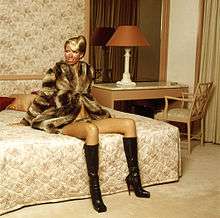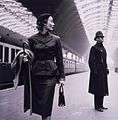Fashion photography

Fashion photography is a genre of photography which is devoted to displaying clothing and other fashion items. Fashion photography is most often conducted for advertisements or fashion magazines such as Vogue, Vanity Fair, or Elle. Over time, fashion photography has developed its own aesthetic in which the clothes and fashions are enhanced by the presence of exotic locations or accessories.
History

Fashion photography has been in existence since the earliest days of photography. In 1856, Adolphe Braun published a book containing 288 photographs of Virginia Oldoini, Countess di Castiglione, a Tuscan noblewoman at the court of Napoleon III. The photos depict her in her official court garb, making her the first fashion model.[1]
In the first decade of the 20th century, advances in halftone printing allowed fashion photographs to be featured in magazines. Fashion photography made its first appearance in French magazines such as La mode pratique. In 1909, Condé Nast took over Vogue magazine and also contributed to the beginnings of fashion photography. In 1911, photographer Edward Steichen was "dared" by Lucien Vogel, the publisher of Jardin des Modes and La Gazette du Bon Ton, to promote fashion as a fine art by the use of photography.[2] Steichen then took photos of gowns designed by couturier Paul Poiret.[2] These photographs were published in the April 1911 issue of the magazine Art et Décoration.[2] According to Jesse Alexander, This is "...now considered to be the first ever modern fashion photography shoot. That is, photographing the garments in such a way as to convey a sense of their physical quality as well as their formal appearance, as opposed to simply illustrating the object."[3]

Vogue was followed by its rival, Harper's Bazaar, and the two companies were leaders in the field of fashion photography throughout the 1920s and 1930s. House photographers such as Edward Steichen, George Hoyningen-Huene, Horst P. Horst and Cecil Beaton transformed the genre into an outstanding art form.
In the mid-1930s as World War II approached, the focus shifted to the United States, where Vogue and Harper's continued their old rivalry. In 1936, Martin Munkacsi made the first photographs of models in sporty poses at the beach. Under the artistic direction of Alexey Brodovitch, Harper's Bazaar quickly introduced this new style into its magazine.
House photographers such as Irving Penn, Martin Munkacsi, Richard Avedon, and Louise Dahl-Wolfe would shape the look of fashion photography for the following decades. Richard Avedon revolutionized fashion photography — and redefined the role of the fashion photographer — in the post-World War II era with his imaginative images of the modern woman.
From 1939 and onward, what had previously been the flourishing and sizeable industry of fashion photography all but stopped due to the beginnings of World War II. The United States and Europe quickly diverged from one another. What had previously been a togetherness and inspired working relationship divulged as Paris was occupied and London under siege. Paris, the main fashion-power house of the time quickly became isolated from the United States—especially with French Vogue shutting down for a brief hiatus in 1940.[4] With these changes, the photography based out of the USA gained a distinct Americana vibe—models often posed with flags, American brand cars, and generally just fulfilling the American ideal. What did remain of the French and British fashion photography on the other hand often had a wartime overlay to the content. Cecil Beaton’s ‘Fashion is Indestructible’ from 1941 displays a well-dressed woman viewing the rubble that once was Middle Temple in London. Similarly, Lee Miller began taking photos of women in Paris and London, modeling the latest designs for gas masks and bicycling with pincurlers in their hair, as they did not have electricity with which to curl their hair.[5] Images such as these remain scarred into the face of fashion photography of the time and display a common sentiment among the fashionable world and the public. Even fashion photographers worked to document the issues surrounding and work towards a documentation of the time—even if within the frame of fashion. These photos are an especially good indication of the fashionable emotions of the time. Many felt that fashion photography, during wartime especially, was frivolous and unnecessary. Yet, the few who worked to preserve the industry did so in new and inventive ways throughout the duration of the war.[6]
In postwar London, John French pioneered a new form of fashion photography suited to reproduction in newsprint, involving natural light and low contrast.[7][8]
In the recent years fashion photography gained an even greater popularity due to the expansion of internet and ecommerce. Clean product, knolling and ghost mannequin photography have become a usual practice in the fashion industry. [9]
Contemporary fashion photography
After the deaths of Richard Avedon, Helmut Newton, Francesco Scavullo, Herb Ritts, and Gleb Derujinsky, some of today's most famous fashion photographers are Patrick Demarchelier, Steven Meisel, Mario Testino, Peter Lindbergh and Annie Leibovitz.[10]
Gallery
-

Paddington Station by Toni Frissell, 1951
-

Photograph of a green brocade silk saree
-

American model Renée Gunter modeling haute couture
See also
- Advertising
- Fashion Design
- Fashion magazines
- Fashion model
- Fashion photographers
- Fashion stylist
- Hair stylist
- List of photographers
- Make-up artist
- photographer
References
- ↑ Abigail Solomon-Godeau, "The Legs of the Countess." October 39 (Winter 1986): 65-108. Reprinted in Fetishism as Cultural Discourse, Emily Apter and William Pletz, eds. (Ithaca and London: Cornell University Press, 1993):266-306.
- 1 2 3 Niven, Penelope (1997). Steichen: A Biography. New York: Clarkson Potter. ISBN 0-517-59373-4, p. 352
- ↑ Alexander, Jesse, "Edward Steichen: Lives in Photography," HotShoe magazine, no.151, December/January 2008, pp.66 – 67
- ↑ Hall-Duncan, Nancy. The History of Fashion Photography. New York: Alpine Book, 1979. Print.
- ↑ Conekin, Becky E. "Lee Miller's Simultaneity: Photographer and Model in the Pages of Inter-War Vogue." Fashion as Photograph: Viewing and Reviewing Images of Fashion. Comp. Eugénie Shinkle. London: I.B. Tauris, 2008. 70-83. Print.
- ↑ Devlin, Polly. Vogue Book of Fashion Photography. London: Thames and Hudson, 1979. Print
- ↑ McCabe, Eamonn (2005). The Making of Great Photographs: Approaches and Techniques of the Masters. Newton Abbot: David & Charles. pp. 120–1. ISBN 0-7153-2220-6.
- ↑ Mendes, Valerie D. (comp.) (1984). John French, fashion photographer. Victoria & Albert Museum. ISBN 0-905209-97-4.
- ↑ Revecka, Natalia. "Fashion Photography and E-commerce".
- ↑ Regina Arriola (2012-05-30). "Annie Leibovitz Shoots Karlie Kloss and US Olympic Team Stars in Miami". Hasselblad Website (Hasselblad.com). Retrieved 2012-06-03.